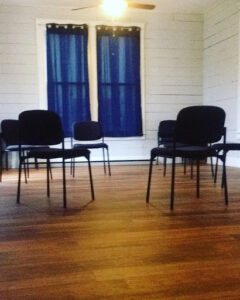Joelle Axton: Part 2, Third Place & Good Neighbor
This is the other half of Joelle’s reflection (see part one), where she explores how the Good Neighbor House aligns with the characteristics of a “third place.” It’s inspiring, and she challenges us all to consider how many different (and “unremarkable”) ways Good Neighbor invites community members to use our house as a “third place” that would be suitable for diverse groups.
When I first read Oldenburg’s characterization of the third place, I had the sense that he had put words to what I was having trouble expressing about the value of a place like the Good Neighbor House. As both a resident volunteer and a member of several groups that meet regularly at Good Neighbor, I had a strong intuitive sense that something of great value was going on at 2301 Colcord, but when I would try explain this intuited sense of value to others, I struggled to articulate the exact nature of the subtle, inconspicuous magic of the house.
On one level of description, there is nothing remarkable going on at Good Neighbor. We provide a space where community groups can meet. As a volunteer on the maintenance committee, it seems that most of our energy is spent simply trying keeping up with the endless list of repairs and renovations that old homes inevitably require. The activities that go on at the house are similarly unremarkable.

Quaker Meeting Space
Every week, our Quaker worship group repeats the simple ritual of sitting silently in a circle for one hour, sharing a snack of hummus and crackers and updates from the week, and restocking the Little Library we steward before departing. The Dharma Friends meditation group shares a similar ritual, except that most of the members of this group sit on cushions on the floor instead of in chairs, and our time of silent sitting is preceded by ten minutes of “walking meditation,” during which the group walks together slowly in a circle around the activity room.[/caption]
What Oldenburg’s analysis of third places has helped me see is that the value of Good Neighbor lies precisely in its simple, unremarkable, “low profile” status. Pretense melts away when people are sitting together on flooring with peeling seams held together by blue painter’s tape. Simple repetitive rituals create warmth and ease that allow us to converse freely and easily, and both light-hearted laughter and heart-breaking grief and struggle are welcome in our circles. The best parts of Good Neighbor cannot be captured in lists of projects accomplished or events hosted or dollars donated. In fact, the magic of the house may be altogether impossible to convey to those who are still “outsiders.”
It is regulars like Jerry, who comes every Sunday to both Quaker meeting and Dharma Friends, and always drinks his tea out of his special mug that he keeps in his designated spot, and reminds us every week that “our separateness from one another is an illusion,” who make the house a home for those of us who frequent it. When newcomers or visitors come to the Dharma Friends meditation for the first time, almost without exception, they make a comment along the lines of, “There is really good energy in this room,” or “I feel warmth and safety in this circle.” As a regular participant in Dharma Friends, I can attest to the special quality of the group. There is a noticeable sense of calm and caring in the room, and I think this “good energy” is easier to notice against the backdrop of the simple, homey atmosphere of the house.
Good Neighbor does not fit perfectly into Oldenburg’s category of “third place.” For example, as an all-volunteer organization, we cannot be open (accessible) 24/7 or “accommodate” every request. Nevertheless, at its best, I think Good Neighbor serves as a place where people feel safe to be themselves. The strength of third places lies in the fact that the place itself (whether it is a business or a building run by a non-profit or a municipal entity) is not caught up in pushing its own agenda. The people who use third places usually pay very little attention to the details of the organization or business which provides the space, and instead focus on the joyful human interactions that occur there. Paradoxically, low profile spaces are best at promoting high quality social interactions.
My housemates and I affectionately refer to Good Neighbor as “the good house,” and I’ve become attached to this title because living and volunteering at the house helps me maintain my admittedly naïve faith in the simple goodness of people and the beautiful humanism underlying the best parts of our society. Thriving communities are held together by the exchange of ideas and social capital built inside crumbling buildings sometimes held together by tape. I’m proud and thankful to be a participant in this quiet work.
Joelle has inspired me to consider my own understandings and uses of “third places,” and I will share my reflections here in the next few weeks.
If you would like to share your thoughts, we welcome comments and / or you can contact us about publishing a longer piece to post (info@goodneighborwaco.org).

Recent Comments